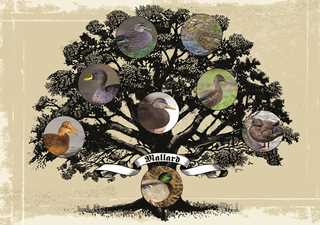Understanding Waterfowl: Mallards and Their Relatives
These highly adaptable ducks are found in a variety of habitats across the globe
These highly adaptable ducks are found in a variety of habitats across the globe
By J. Dale James, Ph.D.
Widely distributed across North America, Asia, and Europe, the mallard is the most abundant duck in the northern hemisphere. Mallards are successful because they are adaptable, which allows them to exploit diverse habitats and resources. Mallards are also one of the most prolific breeders in the waterfowl world. In some cases, hen mallards have been observed making up to six nesting attempts in a single breeding season.
North America has more mallards than any other continent, supporting an average annual breeding population of about 10 million birds in surveyed regions. While mallards are now found across much of the United States and Canada, they were once relatively rare in the Atlantic Flyway. In fact, mallards did not begin to move east in significant numbers until sometime around 1900.
Historically, the mallard's close relative, the American black duck, was the most abundant duck in the Atlantic Flyway, and black ducks were once far more numerous in the Mississippi Flyway than they are today. Black duck breeding populations have declined by more than 50 percent since the late 1950s. Habitat loss and competition and hybridization with mallards are believed to be the primary causes of past black duck declines. In recent decades, black duck numbers appear to have stabilized, with an average annual breeding population of approximately 600,000 birds in the eastern survey area.

While black ducks fill a more geographically distinct niche than the mallard, they use an equally diverse range of wetlands, including beaver ponds and other forested wetlands; fresh, brackish, and saltwater marshes; inland lakes; and estuaries. Like mallards, black ducks consume a predominantly vegetarian diet consisting of seeds and other plant materials. They also eat animal matter such as snails, mussels, shrimp, and other invertebrates, especially during the nesting and wintering periods. The primary threat currently facing black ducks is the continued loss of important breeding, migration, and wintering habitats in the eastern United States and Canada. To ensure the sustainability of black duck populations, Ducks Unlimited and its partners are working to conserve key wetland habitats throughout the birds' range and support research to increase our knowledge of this highly prized species.
Another relative of the mallard, which is even more closely related to the black duck, is the nonmigratory mottled duck. There are two distinct populations of mottled ducks in North America. The largest population, which is believed to number more than 600,000 birds, occurs along the Gulf Coast, primarily in south Louisiana and Texas. These birds inhabit non-tidal fresh and brackish coastal marshes as well as emergent coastal prairie wetlands and associated agricultural lands. A smaller population of approximately 40,000 mottled ducks occurs in peninsular Florida. These Florida mottled ducks are typically found in freshwater emergent wetlands, wet prairies, and seasonally flooded marshes. In addition, mottled ducks from the Gulf Coast have been introduced in coastal South Carolina. Important mottled duck foods include rice, moist-soil plant seeds, submerged aquatic vegetation, and invertebrates.
Recent research examining habitat use by mottled ducks in Texas and Louisiana suggests that conserving coastal marshes and sustaining agricultural rice lands will be vital to sustaining healthy populations of these birds. Ducks Unlimited and partners are pursuing both objectives along the Gulf Coast through active wetland restoration and public policy. In addition, DU's new Ricelands Stewardship Program is working to help rice producers secure adequate water resources to meet their agricultural needs as well as provide habitat for waterfowl and other wildlife in this region.
Another mallard relative, long thought to be a separate species but now classified as a subspecies of the mallard, is the Mexican duck. Occurring in parts of Arizona, New Mexico, Trans-Pecos Texas, and farther south into Mexico, Mexican ducks are believed to have a stable or increasing population of approximately 55,000 birds. Preferred habitats of Mexican ducks include rivers, ponds, shallow marshes, and irrigation ditches, where they consume a variety of aquatic vegetation, invertebrates, and even small fish.
Ducks Unlimited is the only organization that actively conserves waterfowl habitat throughout the mallard's vast continental range as well as in the more geographically specific ranges of its North American relatives. Across this continent, wetlands and other waterfowl habitats are at risk, but DU and its partners are determined to ensure a bright future for the birds and the ecosystems they inhabit.
Dr. Dale James is manager of conservation planning at DU's Southern Regional Office in Ridgeland, Mississippi.
Ducks Unlimited uses cookies to enhance your browsing experience, optimize site functionality, analyze traffic, and deliver personalized advertising through third parties. By continuing to use this site, you agree to our use of cookies. View Privacy Policy